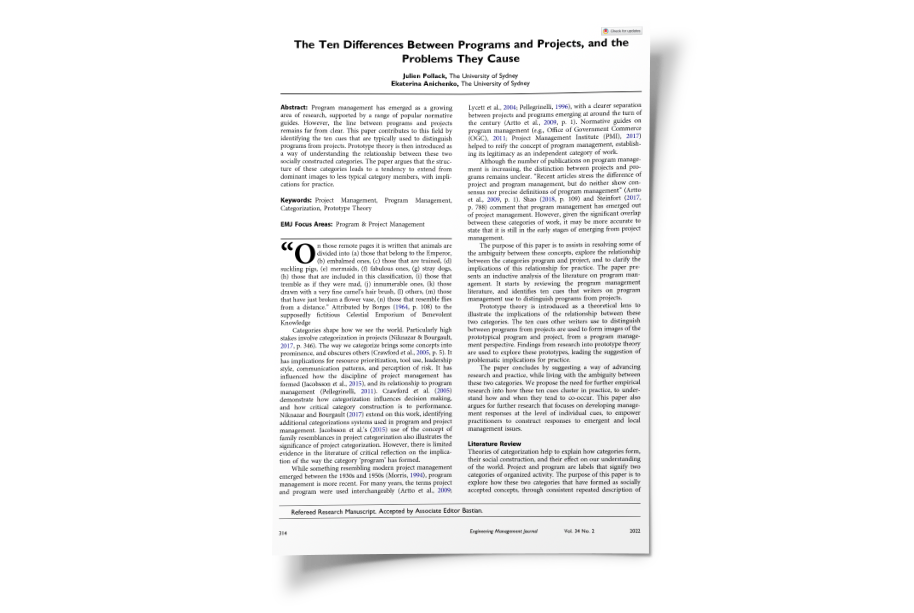The Ten Differences Between Programs and Projects, and the Problems They Cause
Abstract
Program management has emerged as a growing area of research, supported by a range of popular normative guides. However, the line between programs and projects remains far from clear. This paper contributes to this field by identifying the ten cues that are typically used to distinguish programs from projects. Prototype theory is then introduced as a way of understanding the relationship between these two socially constructed categories. The paper argues that the structure of these categories leads to a tendency to extend from dominant images to less typical category members, with implications for practice.
“On those remote pages it is written that animals are divided into (a) those that belong to the Emperor, (b) embalmed ones, (c) those that are trained, (d) suckling pigs, (e) mermaids, (f) fabulous ones, (g) stray dogs, (h) those that are included in this classification, (i) those that tremble as if they were mad, (j) innumerable ones, (k) those drawn with a very fine camel’s hair brush, (l) others, (m) those that have just broken a flower vase, (n) those that resemble flies from a distance.” Attributed by Borges (1964, p. 108) to the supposedly fictitious Celestial Emporium of Benevolent Knowledge
Categories shape how we see the world. Particularly high stakes involve categorization in projects (Niknazar & Bourgault, 2017, p. 346). The way we categorize brings some concepts into prominence, and obscures others (Crawford et al., 2005, p. 5). It has implications for resource prioritization, tool use, leadership style, communication patterns, and perception of risk. It has influenced how the discipline of project management has formed (Jacobsson et al., 2015), and its relationship to program management (Pellegrinelli, 2011). Crawford et al. (2005) demonstrate how categorization influences decision making, and how critical category construction is to performance. Niknazar and Bourgault (2017) extend on this work, identifying additional categorizations systems used in program and project management. Jacobsson et al.’s (2015) use of the concept of family resemblances in project categorization also illustrates the significance of project categorization. However, there is limited evidence in the literature of critical reflection on the implication of the way the category ‘program’ has formed.
While something resembling modern project management emerged between the 1930s and 1950s (Morris, 1994), program management is more recent. For many years, the terms project and program were used interchangeably (Artto et al., 2009; Lycett et al., 2004; Pellegrinelli, 1996), with a clearer separation between projects and programs emerging at around the turn of the century (Artto et al., 2009, p. 1). Normative guides on program management (e.g., Office of Government Commerce (OGC), 2011; Project Management Institute (PMI), 2017) helped to reify the concept of program management, establishing its legitimacy as an independent category of work.
Although the number of publications on program management is increasing, the distinction between projects and programs remains unclear. “Recent articles stress the difference of project and program management, but do neither show consensus nor precise definitions of program management” (Artto et al., 2009, p. 1). Shao (2018, p. 109) and Steinfort (2017, p. 788) comment that program management has emerged out of project management. However, given the significant overlap between these categories of work, it may be more accurate to state that it is still in the early stages of emerging from project management.
The purpose of this paper is to assists in resolving some of the ambiguity between these concepts, explore the relationship between the categories program and project, and to clarify the implications of this relationship for practice. The paper presents an inductive analysis of the literature on program management. It starts by reviewing the program management literature, and identifies ten cues that writers on program management use to distinguish programs from projects.
Prototype theory is introduced as a theoretical lens to illustrate the implications of the relationship between these two categories. The ten cues other writers use to distinguish between programs from projects are used to form images of the prototypical program and project, from a program management perspective. Findings from research into prototype theory are used to explore these prototypes, leading the suggestion of problematic implications for practice.
The paper concludes by suggesting a way of advancing research and practice, while living with the ambiguity between these two categories. We propose the need for further empirical research into how these ten cues cluster in practice, to understand how and when they tend to co-occur. This paper also argues for further research that focuses on developing management responses at the level of individual cues, to empower practitioners to construct responses to emergent and local management issues.
Potential Industry Impact
- Offers governance and method that is more appropriate for the work rather than two sizes fit all.
- Ideally, allows people to build methodologies based on the characteristics of the work rather than taking a cookie cutter approach.
Academic Impact
- Sets the ground for focussing on not whether something is a program or a project but the specific characteristics.

Authors:
Julien Pollack, Ekaterina Anichenko
Journal:
Engineering Management Journal, Volume 34, Issue 2 (2022)
Read:
https://doi.org/10.1080/10429247.2021.1900661



Leave a Reply